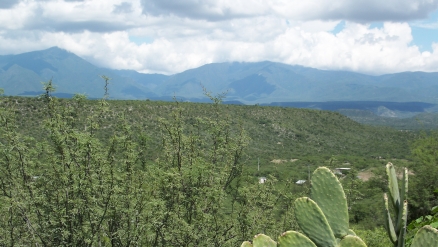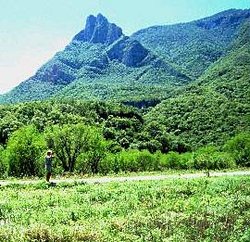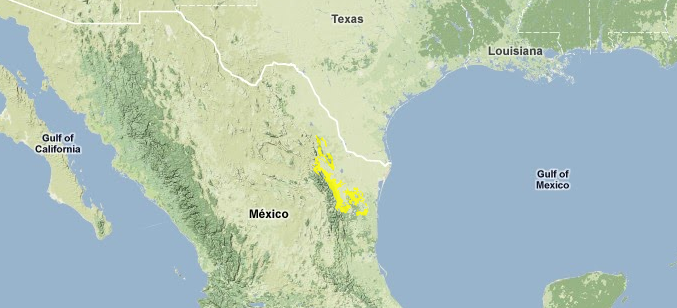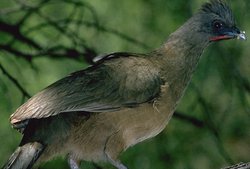Tamaulipan matorral
This unique Tamaulipan Matorral ecoregion lies in Northern Mexico with its southern limit along the line between the nearctic and neotropical realms.
Sever frosts, however limit the species capable of living in this ecoregion. Xeric conditions also contribute to species limitations as the small quantities of rain that does fall is quickly soaked up by the limestone base.
Desert like conditions are perfect for succulents such as cacti, which exist in such numbers in this ecoregion that it is, designated a priority area for their protection.
Location and General Description
The region is formed by the lower elevations of the Sierra Madre Oriental that gradually diffuse into the northeastern coastal province of Tamaulipas. One part of the region is composed of abrupt mountains, but low valleys and vast plateaus mostly dominate it. Geologically, sedimentary rocks of marine origin characterize the ecoregion. These rocks are characteristic for their abundant faults and folding. The climate is dry, and precipitation levels are below 1000 millimeters (mm) per year.
Botanically, the region is composed of a desert scrub that is different from the plant associations occurring in the Chihuahuan desert or in the Central Plateau. Dominant plant species are Opuntia leptocaulis, O. lindheimeri, Prosopis juliflora, P. laevigata, Yucca treculeana, Salvia ballotaeflora, Jatropha dioica, cenizo (Leucophyllum texanum), Mammillaria hemisphaerica, tepeguaje (Leucaena pulverulenta) and Mimosa biuncifera, among many others. At the base of the Sierra Madre Oriental mountains, shallow soils derived from sedimentary rocks support a particular community known as piedmont scrub. This scrub is composed of relatively short plants (3 to 5 meters (m)) growing in dry environments (450-900 mm/year) at altitudes below 2000 m. Dominant species are Helietta parvifolia, Neopringlea integrifolia and Acacia spp. Also near the Sierra Madre Oriental, a montane chaparral grows on regions above 1700 m. In these areas Quercus is the dominant genus but Arbutus, Yucca, Cercocarpus and Bauhinia can also be found. The scrub is generally well represented by many leguminosae, and the herbaceous stratum in this region is rich in species.
Biodiversity Features
The Tamaulipan matorral constitutes a unique assemblage of plant and animal species, and due to the geological history of the region, has outstanding biodiversity features. This region has high numbers of endemic cacti that are greatly appreciated, and also exploited, by foreign collectors. The region is considered among the priority areas for conservation of succulents. An important portion of the habitat for Agave victoria-reginae, an endemic species, lies in this ecoregion. The region is considered as a center of radiation and speciation of the plant family Lamiaceae. It also contains at least four endemic genera of woody plants including Clappia, Nephropetalum, Pterocaulon and Runyonia. Of the 151 species of endemic agavaceae that live in Mexico, 75 have restricted distributions in areas that served as "ecological" islands in the past; the Tamaulipan matorral is one of these areas.
In addition, this ecoregion provides habitat for the highly endangered Mexican prairie dog (Cynomys mexicanus). Other mammal species present in this xeric ecoregion include Saussure’s shrew (Sorex saussurei), yellow-faced pocket gopher (Pappogeomys castanops), and Allen’s squirrel (Sciurus alleni), collared peccary (Pecari tajacu) and coyote (Canis latrans). Many bird species also utilize this ecoregion such as the burrowing owl (Athene cunicularia), hooded oriole (Icterus cucullates), eastern meadowlark (Sturnella magna), long-billed thrasher (Taxotoma longirostre), hooded yellowthroat (Geothlypis nelsoni), blue bunting (Cyanocompsa parellina) and olive sparrow (Arremonops rufivirgatus).
Current Status
Despite being situated in a highly populated area of Mexico, the Tamaulipan matorral is still in relatively good condition. Few protected areas however have been established to protect this region, although several have been proposed to be established. The main challenge lies in achieving good management programs that take into account the needs of the local villagers and combine them with biological conservation goals.
Types and Severity of Threats
The main threats are land conversion for agriculture, goat, sheep and cattle farming, livestock grazing, collection of plants and animals and urban expansion. In the valley of Jaumave, the land is commonly converted to agricultural fields by the burning of native vegetation. Cacti and other succulents, some of which have very narrow distribution, are badly damaged or die during this process. Most of the fires are uncontrollable, constituting a major threat to the plant communities of the region. Construction of dams, road opening, mining and expansion of urban areas also causes habitat destruction. Besides these, illegal extraction and trade of exotic plant species has lead many cacti to acquire endangered status. Some desert animals have long been considered "enemies" to human communities or their domestic fauna; thus they have been deliberately and intensely removed from their original habitat. For example, intentional poisoning has made the Mexican prairie dog one of the most endangered species of mammals in Mexico.
References
- Challenger, A. 1998. Utilización y conservación de los ecosistemas terrestres de México. Pasado, presente y futuro. ISBN: 9709000020
- CONABIO Workshop, 17-16 September, 1996. Informe de Resultados del Taller de Ecoregionalización para la Conservación de México.
- CONABIO Workshop, Mexico, D.F., November 1997. Ecological and Biogeographical Regionalization of Mexico.
- Ferrusquía-Villafranca, I. 1993. Geología de México: una sinopsis. Pages 3-108 in T. P. Ramamoorthy, R. Bye, A. Lot, y J. Fa, (editors). Diversidad Biológica de México. Orígenes y Distribución. Mexico: Instituto de Biología, UNAM.
- García-Mendoza, A. 1995. [http://www.ecologia.unam.mx/laboratorios/evolucionmolecular/info/agave/furcraea.html Riqueza y endemismos de la familia agavaceae en México.
- Goldman, E A., and R. T. Moore. 1946. The biotic provinces of Mexico.
- Marroquín, J.S., G. Borja, R. Velázquez, y J.A. de la Cruz. 1981. Estudio ecológico y dasonómico de las zonas áridas del norte de México, Publicación Especial 2. México: Instituto Nacional de Investigaciones Forestales, SARH.
- Miller, B., G. Ceballos, and R. Reading. 1994. The prairie dog and biotic diversity.
- Oldfield, S. (Comp). 1997. Cactus and succulent plants.
- Ramamoorthy, T. P., y M. Elliott. 1993. Lamiaceae de México: diversidad, distribución, endemismo y evolución. Pages 501-526 in T .P. Ramamoorthy, R., Bye, A. Lot, y J. Fa, (editors). Diversidad Biológica de México. Orígenes y Distribución. Mexico: Instituto de Biología, UNAM.
- Rzedowski, J. 1978.Vegetación de Mexico.
| Disclaimer: This article contains certain information that was originally published by the World Wildlife Fund. Topic editors and authors for the Encyclopedia of Earth have edited its content and added new information. The use of information from the World Wildlife Fund should not be construed as support for or endorsement by that organization for any new information added by EoE personnel, or for any editing of the original content. |
Citation
World Wildlife Fund (2014). Tamaulipan matorral. eds. Mark McGinley and C. Michael Hogan. Encyclopedia of Earth. National Council for Science and Environment. Washington DC. Retrieved from http://editors.eol.org/eoearth/wiki/Tamaulipan_matorral



